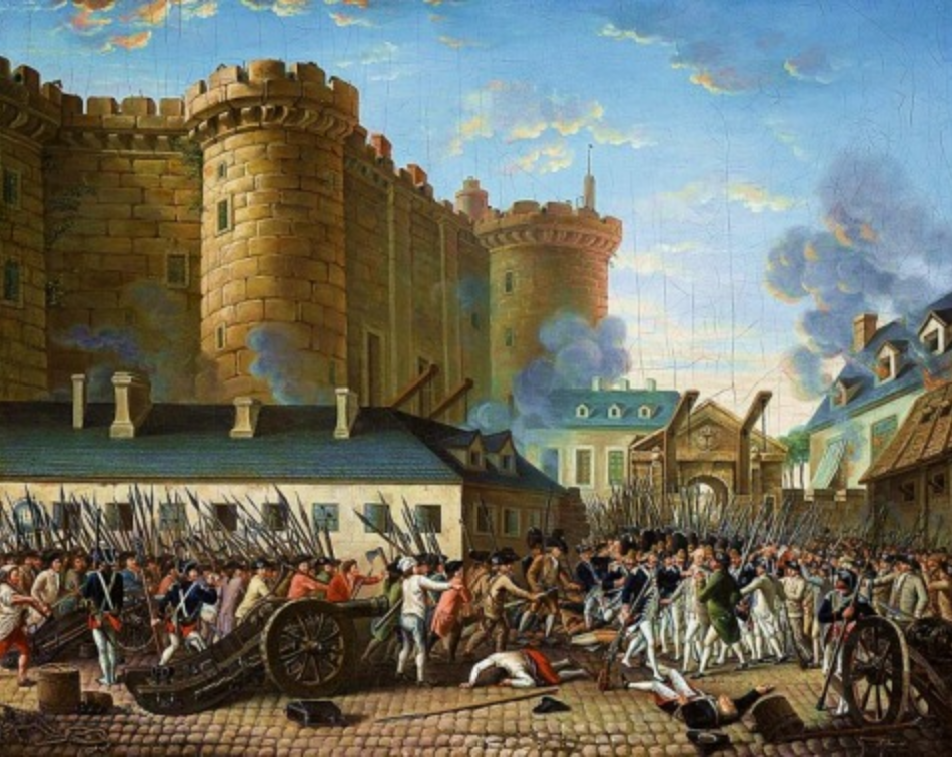Introduction
The late 18th century in France was a period of turmoil and hardship in society. People were constantly protesting against the reigning monarch Louis XVI, the working class and peasantry were becoming increasingly unhappy, the society was experiencing an economic crisis, people were protesting for their rights etc. On July 14, 1789, people started opposing the monarch violently, as the rumour was spread that the king had instructed the soldiers to fire on protesters. They made a military of 7000 people and stormed the state fortress jail, the Bastille, looking for ammunition. They destroyed government buildings and other facilities. This was the beginning of the French Revolution.

Society during 18th century France
French society is divided into 3 classes,
- The first class-which comprises clergy and wealthy people.
- The second class-which comprises noblemen.
- The third-class -comprises the other remaining society which includes all people, from merchants, businessmen, small peasants, servants etc.
- Both the upper classes had all the privileges while the third class played for their privileges and lived in poverty, with a lack of food and political recognition.
- With the population growth, the amount of food started falling short. And due to bad harvest, there was a severe scarcity of food. This led to fights between people for food and other resources.
- Due to the shortage of grains, the prices of the available food grains were increased to a great extent and as a result, the people of the third-class experienced food scarcity even more.
- The social conditions during the 18th century were very bad and hence were one of the reasons for the French Revolution to take place.
The outbreak of the revolution
The outbreak of the revolution took place in the following way-
- The controller general of finances, Charles de Calonne, organized the assembly of nobles in February 1787 to discuss the increase in tax to eliminate the budget deficit. He proposed the privileged class should be taxed, but the assembly rejected that proposal.
- The monarch convened the assembly of estate generals on May 5, 1789. The clergy, the noble estate, sent 300 representatives, while 600 individuals were sent by the third estate which had to assemble in the back of the room.
- In this assembly, each estate had one vote to give despite the number of individuals. The third estate wanted that each member should get the right to vote in the assembly. This demand of the third class was not accepted, and hence they walked out of the assembly.
- The representatives of the Third State then gathered on June 20 in the Versailles Hall where they proclaimed themselves to be the national assembly with the mission of drafting the French constitution to restrain the monarch’s authority. The first estates also joined hands with the third estate and the national constituent assembly was formed.
- In October, the assembly was introduced to restrict the powers of the king and distribute them amongst different institutions.
- The national assembly was indirectly elected and granted the authority to enact laws. Men over 25 who paid taxes were given the ability to vote.
- Although the king had signed the constitution, he secretly negotiated with the king of Prussia and other neighbouring rulers to send the troops to end the national assembly, but before it could happen the national assembly itself declared war on Austria and Prussia in 1792.
- Later that year, the assembly reassembled and decided to arrest the royal family.
- As part of the reforms, all men over 21 were now permitted to vote, regardless of their income.
- Following the election, the national assembly changed into the national convention, which on September 21, 1792, declared France to be a republic and dissolved the monarchy.
Summary
One of the most significant historical occurrences was the French Revolution. It was a struggle between the common people and France’s autocratic ruler. It was the first time that individuals battled for freedom and liberty. All subsequent revolutions were greatly impacted by the French Revolution, which marked a turning point in the struggle for liberty.
Frequently Asked Questions
1. What exactly were tithes?
Ans: The church collected tithes as a form of interest tax. Tithes included one-tenth of the agricultural output.
2. Which club did the Jacobins belong to?
Ans: The Jacobins Club was an underground organization made up of regular people during the French Revolution that was instrumental in overthrowing the monarchy in 1792. This group included small peasants, shopkeepers, laborers etc.
3. Why did the enraged mob storm the Bastille?
Ans: An enraged mob broke into the Bastille early on July 14, 1789, and destroyed the structure because it was a symbol of the monarch’s repressive and tyrannical rule.
 Mission Statement
Mission Statement
“Empower every student to achieve full potential”
88Guru has been established with the social objective of making quality video-based learning material available to all Indian students. Technology, Connectivity and Social Media are rapidly changing the world of Education and we wish to lead the transformation of the tuition industry in India.
88Guru is the perfect complement to the current tuition model. 88Guru creates a wonderful opportunity for children and parents to bond while engaging in a valuable learning activity. It also provides the complete curriculum at your fingertips for those moments when you need some help at short notice. We believe that this mode of tuition could be transformational, adding hours to a child's day while providing complete control over the learning process.
Every course is taught by the best teachers from India's top schools and conducted in an engaging manner to keep students involved. The e-learning process consists of video-based instructions, computer-graded assignments, and a dashboard which allows the student and parent to track progress.


